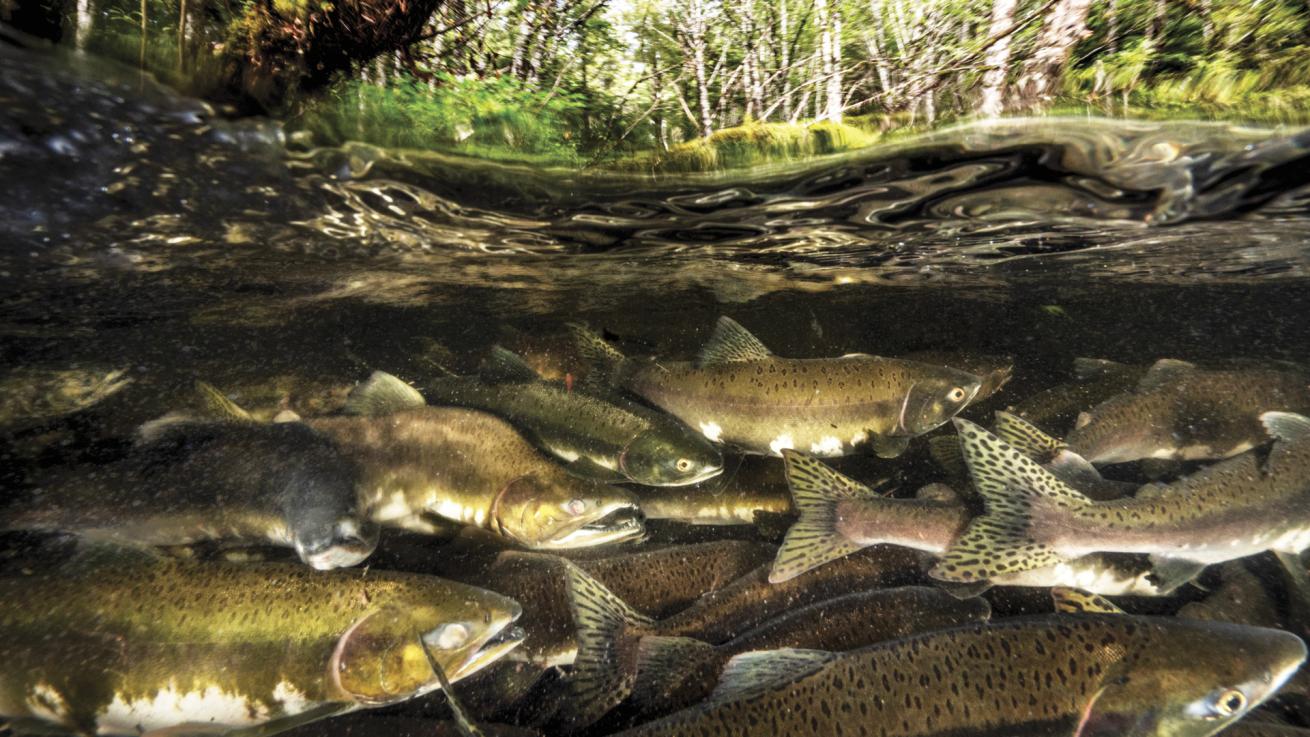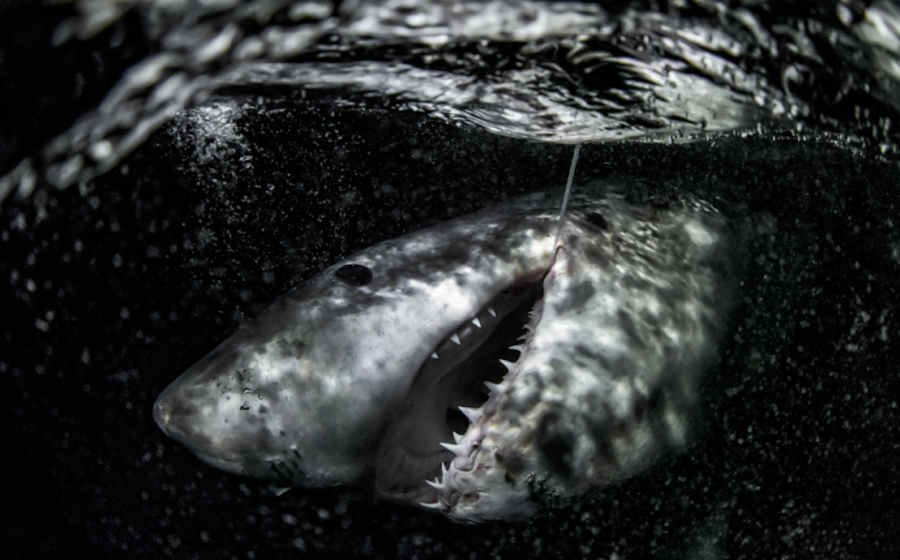The Power of Alaska's Salmon Forest

Patrick WebsterAn aggregation of pink salmon gathers under the forest their bodies will feed.
Time: 1300 hours
Month/Year: September 2022
Location: Southeast Alaska, approx.
Longitude/Latitude: 57°33'N 135°31'W
Water Temperature: 48ºF / 8.8ºC
Dark clouds of indecisive rain hang over the thickly forested slopes lining our eerily still back bay on the edge of Shee Kaax (Chichagof Island). Nearby lies Peril Strait, home to Poison Cove and Deadman’s Reach—foreboding names that tell tale of murderous mussels made poisonous by a toxic algal bloom that ravaged a Russian and Aleut fur seal hunting party in 1799. Southeast Alaska is a powerful place, best appreciated on these dreary days, when the raw energy of the coast flows through the mist from the tops of the rainforest and back to the sea.
I roll off the Zodiac into the dark green fjord flushed by nearby streams and strengthening rains.
The scene is surreal under the surface. A rippling halocline of fresh water filled with brown tannins from rotting wood and bog wash paints the underworld an emerald green hue. On the distant reef are spot prawns, myriad sea cucumbers and urchins, and dungeness and rock crabs—a fine ciopinno dinner for the sea and river otters that patrol the area.
My buddy Kayvon and I never make it to the seafloor, staying suspended instead in the midwater to document the smack of gelatinous drifters surrounding us— 20-foot-long lion’s mane jellies, glowing moon jellies and see-through crystal jellies, hurried curtained jellies and more. The surrounding darkness makes each glow ethereally in the alien landscape.
Related Reading: Exploring the Falkland Islands' Flourishing Kelp Forests

Patrick WebsterA male pink salmon heads upstream to spawn and then die in the brisk waters of Ketchikan Creek, Alaska.
Then a bright, golden object floating just under the surface breaks the reverie. I ascend slowly and see the wasting carcass of a dog salmon, aka chum salmon. Bent in half by death’s rigor, it sits exactly at the surface, bathed in the golden light of the tannin-tinted estuary.
I raise my camera, using Snell’s window to peer out to the trees and clouds lining the nearby stream that this salmon spent its whole life instinctually dreaming to return to.
After a few short years navigating the open ocean, it had just punched its oneway ticket home, spawning and dying where generations upon generations of its species had done before.
Eventually, I get the image I was looking for: salmon, spruce and sky, all in one, one in all.
The Tongass is one of the world’s most productive forests, where waters and woods feed off of each other, with its five species of salmon importing the raw energy of the open ocean into the coast range, supercharging the bears, the eagles and the trees in a gluttonous orgy of death and life that would make the Romans blush.
The forest here has a seafood diet, its imposing strength borrowed from the Pacific and found in its nitrogenous signatures to the very tips of the old-growth hemlocks. And then the young salmon will leave their wooded nursery, and swim where I once did and gobble up the jellies I was so entranced by, molecularly upgrading them to the next level of the food ladder until that jelly salmonquantum has a tree-top view.
Looking back from the salmon, I realize then how empty the scenery has been all around me, like looking onto a stage at the props and curtains and lights and empty seats after the play has passed. Weeks prior, this basin may have seen thousands of adult salmon gathering for their final act, perhaps hunted by sea lions and orca as they assembled. And next year the fry will fly past Hawaiian humpback whales waiting in the wings, through the very fjord Kayvon and I found in one of its emptied states, full of life promise. So, what did we really see on our dive, on any dive really? One snapshot in time, one thread in the infinite weave between the land and its ocean.
Related Reading: What It’s Like to Swim With Humpback Whales
The young salmon will leave their wooded nursery, and swim where I once did and gobble up the jellies I was so entranced by, molecularly upgrading them to the next level of the food ladder until that jelly-salmon-quantum has a tree-top view.
A year later and I’m in Ketchikan, dive gear at the ready for more fjord exploring. But in the morning I suit up and bring myself and the camera away from the beach, up the river, beyond a waterfall, to a quiet staging pool filled with thousands of amorous pink salmon. I dip my camera in and see the Pacific Ocean taking a bucket-list trip to the forest that watched over them.
The power of Alaska’s Salmon Forest comes from these fish that live their fullest lives, bringing their ocean stories home. I suppose then that we as divers aren’t so dissimilar. We’re ephemeral ocean creatures too, with the ability to feed our land-based communities with a deeper connection to their ocean, just like the salmon do, weaving land and sea together with each new story spawned to dive.










